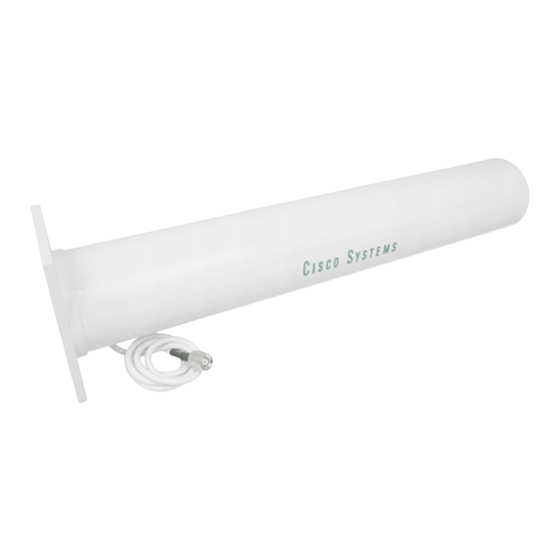Table of Contents
Advertisement
Quick Links
Cisco Aironet 13.5-dBi Yagi Mast Mount Antenna
(AIR-ANT1949)
Overview
This document describes the 13.5-dBi Yagi mast mount antenna and provides instructions for mounting
it. The antenna operates in the 2.4- to 2.5-GHz frequency range and is designed for point-to-point
communications. The antenna is a completely enclosed 16-element, vertically polarized directional Yagi
and is designed to be mounted outdoors on a mast. The antenna can also be used indoors and can be
mounted on a flat vertical surface, such as a wall.
The following information is provided in this document.
•
•
•
•
•
•
•
Corporate Headquarters:
Cisco Systems, Inc., 170 West Tasman Drive, San Jose, CA 95134-1706 USA
© 2006 Cisco Systems, Inc. All rights reserved.
Technical Specifications, page 2
System Requirements, page 2
Installation Notes, page 4
Choosing a Mounting Location, page 5
Tools and Equipment Required, page 5
Mounting the Antenna, page 6
Advertisement
Table of Contents

Summary of Contents for Cisco Aironet AIR-ANT1949
-
Page 1: Table Of Contents
The antenna is a completely enclosed 16-element, vertically polarized directional Yagi and is designed to be mounted outdoors on a mast. The antenna can also be used indoors and can be mounted on a flat vertical surface, such as a wall. -
Page 2: Technical Specifications
Elevation Radiation Pattern System Requirements This antenna is designed for use with Cisco Aironet access points and bridges but can be used with any 2.4-GHz Cisco Aironet radio device that uses a reverse-polarity threaded naval connector (RP-TNC). Cisco Aironet 13.5-dBi Yagi Mast Mount Antenna (AIR-ANT1949) -
Page 3: Safety Precautions
Each person should be assigned to a specific task, and should know what to do and when to do it. One person should be in charge of the operation to issue instructions and watch for signs of trouble. -
Page 4: Installation Notes
Step 3 If you lose control of the mast while raising it, make sure that it does not fall in the wrong direction. Use a durable non-conductive rope secured at each 2-foot level as the mast is raised. Have an assistant tend the rope, ready to pull the mast clear of any hazards (such as power lines) if it begins to fall. -
Page 5: Choosing A Mounting Location
Generally, the higher an antenna is above the ground, the better it performs. Good practice is to install your antenna about 5 to 10 ft (1.5 to 3 m) above the roof line and away from all power lines and obstructions. -
Page 6: Mounting The Antenna
Mounting the Antenna The antenna is provided with a mast mounting kit that allows you to mount the antenna to masts up to 1 5/8 in. in diameter. Figure 1 shows how the antenna should be mounted to a mast or wall. - Page 7 Use a 7/16-in (11.1-mm) wrench or suitable adjustable wrench to secure the assembly to the mast. Step 4 Tighten the locknuts to a point where the antenna does not slide down the mast but is loose enough for you to rotate.
-
Page 8: Obtaining Documentation And Submitting A Service Request
Cisco currently supports RSS Version 2.0. Cisco and the Cisco Logo are trademarks of Cisco Systems, Inc. and/or its affiliates in the U.S. and other countries. A listing of Cisco's trademarks can be found at www.cisco.com/go/trademarks. Third party trademarks mentioned are the property of their respective owners. The use of the word partner does not imply a partnership relationship between Cisco and any other company.
















